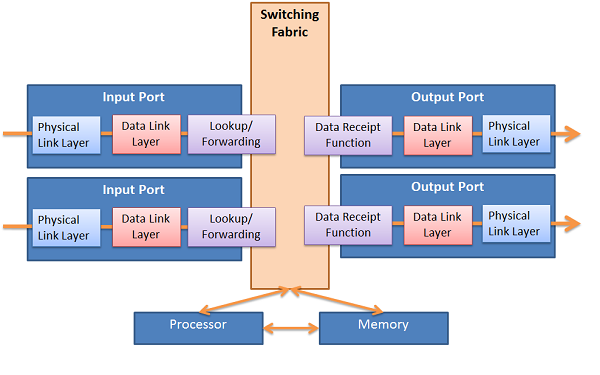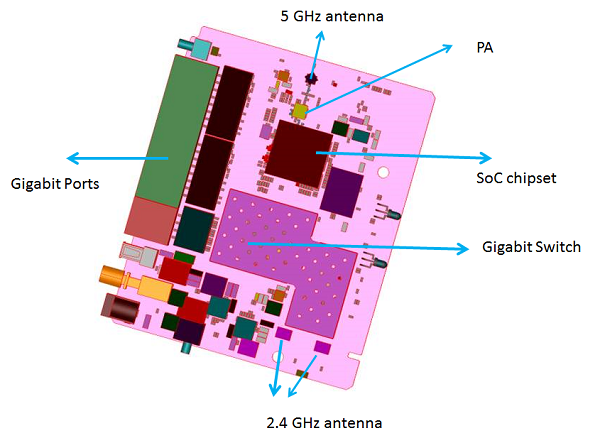Router SoC 101
Do you ever wonder what goes on inside a router? In this article, we take a close look at the SoCs inside of them, which help us manage and maintain our connected lives.
Router SoC Functional Components
In a router SoC, packetized data arrives through input ports, is directed using a network of connections called the Switching Fabric (which can be thought of as wires connecting each component to every other), and leaves through output ports.
The router SoC keeps, in memory, a look-up table of addresses associated with each packet, and the processor uses various rule sets to determine the best path for sending data. It also listens in to keep tabs on network traffic, updating its "available" and/or "best" path for packets based on load levels.
The SoC's on-board memory maintains routing tables, consisting of network and host addresses. To determine the best path for delivering a packet to its destination, the routing table includes all known network addresses, instructions for connecting to other networks, possible paths between routers and a measure of distance between nodes or network addresses known in the form of cost functions. This on-board memory usually takes the form of flash or EEPROM. The size of the memory chip is less important than its speed.
By their nature, routers do not communicate directly with end devices like laptop or desktop computers, but with their network adapters. Each NIC has a network address—Ethernet switches, adapters, Wi-Fi transceivers and radios are all NICs.
Additional hardware can provide dedicated support to the main CPU. A cryptographic chip can offload encryption and hashing functions from the main processor. A dedicated load balancer can jump in to optimize different types of data streams—streaming video versus regular Web page browsing, for example. USB, SATA and other types of capabilities on routers are also added in the form of interface cards, often integrated right into the main processor board.
The architecture gets more complex when you consider that many routers also provide an xDSL, cable or cellular data modem. In this case, the router's interface card is the component that mediates data between the modem and switching fabric.
A modem modulates and demodulates digital signals into analog and vice versa, to be sent out over the "line"—cable or xDSL. However, we will not cover cellular modems in this article; those require architecture and protocol different from xDSL or cable modems.
Get Tom's Hardware's best news and in-depth reviews, straight to your inbox.
Current page: Router SoC Functional Components
Prev Page Introduction Next Page Processors And Transceivers-
bwhiten Uhhhh...Those first pictures are not "schematics". They are CAD renderings of the box and main board at best, but definitely not schematics.Reply -
EdJulio ReplyUhhhh...Those first pictures are not "schematics". They are CAD renderings of the box and main board at best, but definitely not schematics.
Thanks, bwhiten. Updated the caption...
-
bit_user Nice article!Reply
Small, irrelevant fact: MIPS was once owned by SGI and used in their servers and workstations. They even used a MIPS CPU in the N64, which they designed for Nintendo. In fact, that was largely the outcome of a previous (if not the first) wave of VR hype. But, I digress...
Also, most people consider ARM to be RISC. Or, at least as much as anything is, these days. Indeed, the name once stood for Advanced RISC Machines.
But I didn't know what MIPS originally stood for, so thanks for that. I wonder whether or how long that remained true of their architectures. -
EdJulio Reply17548227 said:Nice article!
Small, irrelevant fact: MIPS was once owned by SGI and used in their servers and workstations. They even used a MIPS CPU in the N64, which they designed for Nintendo. In fact, that was largely the outcome of a previous (if not the first) wave of VR hype. But, I digress...
Also, most people consider ARM to be RISC. Or, at least as much as anything is, these days.
Thanks! I'll share this with Gene! Cheers!!! -
bit_user Reply
Thanks, but I did say it was irrelevant. It really has no bearing on the routers using these chips.17548234 said:Thanks! I'll share this with Gene! Cheers!!! -
GeneFabron ReplyNice article, is there any more on how tech works? Like cpu and gpu?
Hi QuangT, we have a Wireless Routers 101 http://www.tomshardware.com/reviews/wireless-routers-101,4456.html and a PSUs 101 http://www.tomshardware.com/reviews/power-supplies-101,4193.html article, and there will be more coming soon! -
Gabriel_1965 Question: I've seen a router with 72 cores would that be made to be a 72 core pic and I could use the cores for multi ore computing?Reply

